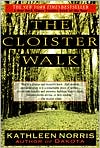Why would a married woman with a thoroughly Protestant background and often more doubt than faith be drawn to the ancient practice of monasticism, to a community of celibate men whose days are centered around a rigid schedule of prayer, work, and scripture? This is the question that Kathleen Norris herself asks as, somewhat to her own surprise, she found herself on two extended residencies at a Benedictine monastery. Yet upon leaving the monastery, she began to feel herself transformed, and the daily events of her life on the Great Plains – from her morning walk to her going to sleep at night – gradually took on new meaning. She found that in the monastery, time slowed down, offering a new perspective on community, family, and even small-town life. By coming to understand the Benedictine practice of celibacy, she felt her own marriage enriched; through the communal reading aloud of the psalms every day, her notion of the ancient oral tradition of poetry came to life; and even the mundane task of laundry took on new meaning through the lens of Benedictine ritual. Writing with lyrical grace, Kathleen Norris here takes us through a liturgical year, as she experienced it both within the monastery and outside it. She shows us, from the rare perspective of someone who is both insider and outsider, how immersion in the cloistered world – its liturgy, its rituals, its sense of community – can impart meaning to everyday events and deepen our secular lives. Through her masterly prose and rare insight, the monastery, often considered archaic or otherworldly, becomes immediate, accessible, and relevant to us, no matter what our faith may be.
Publishers Weekly
The allure of the monastic life baffles most lay people, but in her second book Norris (Dakota) goes far in explaining it. The author, raised Protestant, has been a Benedictine oblate, or lay associate, for 10 years, and has lived at a Benedictine monastery in Minnesota for two. Here, she compresses these years of experience into the diary of one liturgical year, offering observations on subjects ranging from celibacy to dealing with emotions to Christmas music. Like the liturgy she loves, this meandering, often repetitive book is perhaps best approached through the lectio divina practiced by the Benedictines, in which one tries to “surrender to whatever word or phrase captures the attention.” There is a certain nervous facility to some of Norris’s jabs at academics, and she is sometimes sanctimonious. But there is no doubting her conviction, exemplified in her defense of the much-maligned Catholic “virgin martyrs,” whose relevance and heroism she wants to redeem for feminists. What emerges, finally, is an affecting portrait-one of the most vibrant since Merton’s-of the misunderstood, often invisible world of monastics, as seen by a restless, generous intelligence. (Apr.)







